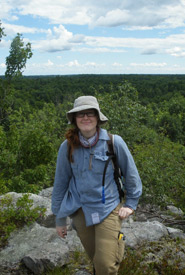A prothonotary warbler partnership takes flight
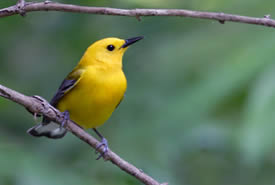
Prothonotary warbler (Photo by Bill Hubick)
Deep in the swamp forest of Backus Woods in Ontario on a hot summer’s day, it’s easy to feel as though one has been transported to somewhere in the Mississippi basin. The thick canopy of mature Carolinian trees provides shade to seasonal standing water, which looks like a mirror on the forest floor. The reverberating song of the bright golden prothonotary warbler can be heard bouncing off the water, echoing throughout the forest.
“It’s as though their song is designed for that kind of habitat,” says Jody Allair of Bird Studies Canada (BSC). “Males look like a gleaming gold brick in the dark forest. They seem to pick the best spots to perch above water to show off their colours, creating bright reflections.”
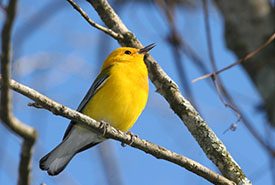
Prothonotary warbler (Photo by Bill Hubick)
Prothonotary warblers (PROWs, to birders) are the only cavity-nesting warbler in Canada, exclusively nesting in modified tree cavities created by black-capped chickadees and downy woodpeckers. Since the warblers don’t create the cavities themselves, they are dependent on mature forests. These forests have had time to accumulate nesting cavities made by other birds over the years, making for opportune PROW habitat.
Allair is currently working on a long-term research project monitoring this warbler and other rare forest birds. The project began in the early 1990s by Jon McCracken, who had been researching prothonotary warblers since the late 1970s. BSC’s monitoring of rare bird populations has been ongoing at several sites, including Backus Woods, ever since.
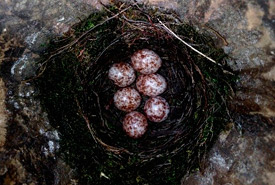
Prothonotary warbler nest (Photo by Jody Allair)
When Backus Woods was purchased by NCC, the two organizations created a long-term research agreement to continue BSC’s forest bird monitoring. These studies help provide broad-scale information about population trends in designated habitats — a win-win for conservation. NCC uses BSC’s research to inform its conservation goals and management of the best breeding habitat for prothonotary warblers in Canada and how to help protect it.
In Backus Woods, BSC uses nest boxes to monitor the prothonotary warbler population. The boxes were designed by Don Wills, a local farmer and dedicated BSC volunteer. Wills has assisted with monitoring this species for the past 15 years, and has created most of the nest boxes used in Backus Woods. His design consists of a log on a pole, which has been hollowed out like a woodpecker cavity. Proven to be a favourite among the species, this design is used at other sites where prothonotary warblers are monitored.
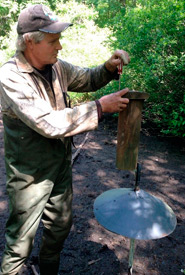
BSC volunteer Don Wills with a custom PROW nest box (Photo by Jody Allair)
Habitat loss is the major limiting factor for this species in Canada. Prothonotary warblers are more common south of the border, but their range appears to be shrinking. They are listed as high conservation concern on both the 2016 State of North America's Birds Report and Audubon’s WatchList, an annual report about birds in need of rapid conservation help. Prothonotary populations used to be much larger in Canada, but as forests are lost and swamps are drained, they are running out of space.
“If we had more habitat, we’d probably have more birds,” says Allair.
NCC's purchase of Backus Woods now ensures that this oasis of habitat will be protected, but the birds here have had their struggles in this forest previously. About 15 years ago, BSC’s monitoring of the population revealed that only one female prothonotary warbler was laying eggs in Backus Woods — and they were infertile.
“We thought the population was done,” says Allair. “It was pretty scary.”
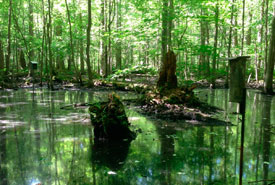
Nest boxes in Backus Woods swamp forest (Photo by Jody Allair)
Since then, prothonotary warblers breeding in Backus Woods have rebounded, but remain one of the rarest breeding birds in Canada. The ones in Backus Woods are doing particularly well compared to other monitoring sites and have nearly a 100 per cent success rate for nests. This is in part because the forest's high quality habitat — mature trees, lots of swampy areas, plenty of food and, in part, because of the nest boxes made by BSC volunteers.Monitoring the reproduction of these birds has given BSC and NCC insight into just how valuable Backus Woods is as breeding habitat for prothonotary warblers. The property likely represents one of the last and best strongholds for the species in Canada. According to Allair, “This is the northern extent of their range, so we don’t really think of them as having multiple successful nests in a year, but one pair has double brooded twice in two years. It’s a really good sign.”
Walking the trails of Backus Woods can give a real taste of what mature Carolinian swamp forests in the region might have been like centuries ago, including containing a diverse bird community. It's one of the few places where you can hear many of the rarest songbirds in Canada, all in the same place, like the echoing “zweet-zweet-zweet” of the prothonotary warbler.
This blog was written by NCC's Liv Monck-Whip and BSC's Jody Allair.

